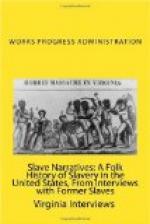“Culture loosens predijuce. I do not believe in social equality at all myself; it cannot be; but we all must learn to keep to our own road, and bear Christian good will towards each other.”
“I do not know of any colored people who are any more superstitious than are white people. They have the advantages of education now equally and are about on the same level. Of course illiterate whites and the illiterate colored man are apt to believe in charms. I do not remember of hearing of any particular superstitious among my church people that I could tell you about, no ma’m, I do not.”
“In church music I hold that the good old hymns of John and of Charles Wesley are the best to be had. I don’ like shouting ‘Spirituals’ show-off and carrying on—never did encourage it! Inward Grace will come out in your singing more than anything else you do, and the impression we carry away from your song and, from the singer are what I count.” Read well, sing correctly, but first, last, remember real inward Grace is what shows forth the most in a song.”
“In New Oreleans where I went to school,—(graduated in 1887 from the Freedman’s Aid College)—there were 14 or 15 colored churches (methodist) in my youth. New Oreleans is one third colored in population, you understand. Some places in the south the colored outnumber the whites 30 to 1.
“I pastored St. Paul’s church in Louieville, a church of close to 3,000 members. No’ma’m can’t say just how old a church it is.”
“To live a consecrated life, you’d better leave off dancing, drinking smoking and the movies. I’ve never been to a movie in my life. When I hear some of the programs colored folks put on the radio sometimes I feel just like going out to the woodshed and getting my axe and chopping up the radio, I do! It’s natural and graceful to dance, but it is not natural or good to mill around in a low-minded smoky dance hall.”
“I don’t hold it right to put anybody out of church, no ma’m. No matter what they do, I don’t believe in putting anybody out of church.”
“My mother and her children were sent to Miss Eliza Sands at Gallipolis, Ohio after Miss Frances Cree’s death, at Miss Frances’ request. Father did not go, no ma’m. He came later and finished his days with us.”
“We went first to Point Pleasant, then up the river to Gallipolis.”
“After we got there we went to school. A man got me a place in Cincinnati when I was twelve years old. I blacked boots and ran errands of the hotel office until I was thirteen; then I went to the FREEDMAN’S AID COLLEGE in N’ Orleans; remained until I graduated. Shoemaking and carpentering were given to me for trades, but as young fellow I shipped on a freighter plying between New Orleans and Liverpool, thinking I would like to be a seaman. I was a mean tempered boy. As cook’s helper one day, I got mad at the boatswain,—threw a pan of hot grease on him.”




